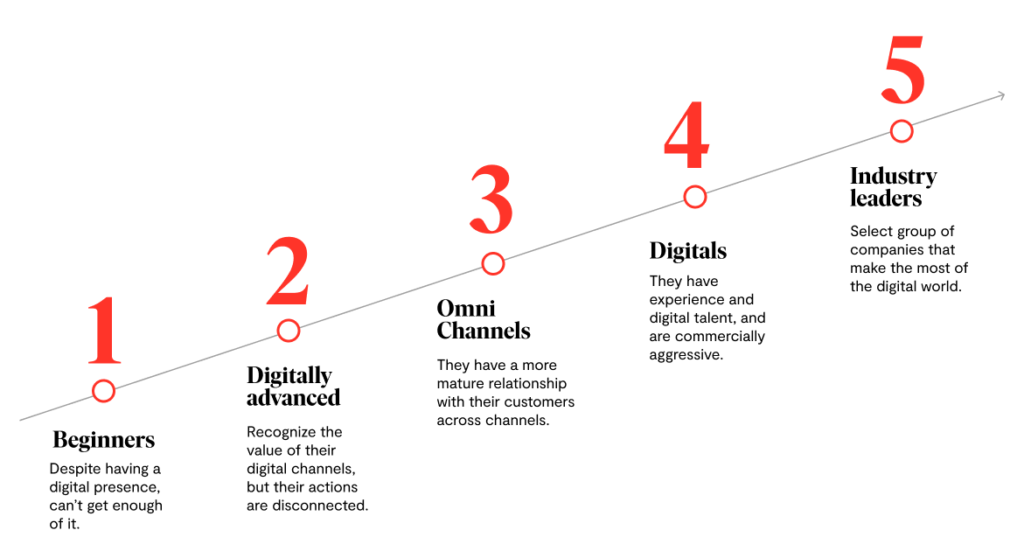Despite the recent increase in process digitization, many businesses are still only halfway there. And, while the promises of digital transformation sound enticing, it is critical to determine an organization’s level of digital maturity before making any decisions.
The term “digital maturity” refers to a company’s stage of adaptation and use of new technological trends, as well as how it operates in digitized and automated processes.
Digital maturity of companies
Companies all over the world are working to accelerate their digitization, regardless of size or industry. According to EY, only 28% of companies in Mexico consider technology important to their business, and they are only now beginning to adopt solutions as a service. When broken down by industry type, telecommunications and financial services stand out as key drivers of transformation processes.
On the other hand, 28 percent of SMEs in Spain are considered digital pioneers, according to a GoDaddy report. Furthermore, 53 percent of these businesses have increased their level of digitization in recent months. Finally, according to Cisco, companies in the United States rank second in terms of digital maturity, only slightly behind Singapore.
To avoid disappointment and work efficiently, it is essential to first determine a company’s level of digital maturity. To accomplish this, Multiplica has created five categories based on a hundred parameters — such as the customer journey, digital supply chain, and marketing personalization, among others — that assess the maturity of these organizations:
- The Beginners (or first-timers): those who, despite having a digital presence, can’t get enough of it. They have few digital initiatives and no specific segmentation that allows them to reach each target more effectively. Internally, the areas continue to work in silos, rather than in a unified, efficient manner that involves all parties.
- The digitally advanced: refers to those who have long recognized the value of their digital channels. While they have specific goals, resources, and a strong desire to move forward with digital transformation, they still have a long way to go. In addition, many tasks are still performed manually, and their work teams are disconnected from one another, making each group’s efforts less efficient.
- The Omni Channels: they have a more mature relationship with their customers, they understand how to cultivate brand consistency across channels, and they recognize what happens with their customers in each interaction. They have already automated a large portion of their communications and can take new leads based on each user’s unique behavior. In general, they provide low-friction digital experiences in which customer service teams or salespeople are aware of previous behavior that users and customers have displayed on the web or in a mobile application.
- The Digitals: they are those who not only have experience, but also talent in the digital world. This enables them to be very commercially aggressive in their attempts to persuade and anticipate their customers. One of its characteristics is the use of various techniques to provide a more personalized message by recognizing the user’s intent. Besides that, they are proactive in getting customers to return to purchases that they have not completed. They are extremely effective at attracting and converting their users into customers by creating a sense of urgency and pressure in the purchase.
- The Industry leaders: it responds to a select group of companies for which there is little to teach about how to make the most of the digital world, because it is precisely these companies that set the standard and have a total customer-centric orientation. They are companies with a culture of constant experimentation, where every hypothesis is tested repeatedly. The organization and communication of the various teams is critical to success in this situation. They shine for brand consistency throughout the journey while applying an adapted and enriched proposal based on what they know about each user and client.

To determine a company’s level of digital maturity, Multiplica has created five categories from Beginners to Industry Leaders.
What is the Multiplica Relevance Index and how does it work?
To determine where an organization is in terms of maturity and to serve as a starting point for moving forward, Multiplica developed the Digital Relevance Index, which allows us to systematize the gathering of information required to carry out a first diagnosis and action plan for a company looking to innovate.
This analysis enables organizations to see the strategic axes that define a relevant experience, as well as the business’s level of compliance in their digital channels.
This tool allows you to quantify, on a scale of 0 to 100, the potential level of relevance of digital relationships that a company manages to develop throughout its users’ and customers’ journeys. Our methodology assesses more than 70 criteria related to the various categories of the journey’s experience axes and business intelligence.
On the other hand, this index provides information about the company’s position in relation to its industry and the market. It then provides a work roadmap with actionable improvements in the short term – early victories – and long term.
Movistar, Liverpool, Dior, Iberostar, Entel, Women’s Secret, Telcel, AFP Provida, and Sprinfield are among the big companies that use Multiplica’s Relevance Index.
“The key to successful marketing is focus, positioning, and differentiation,” said American economist Philip Kotler. To accomplish this, it is necessary to understand the company’s current situation and to implement solid technologies and strategies that will help it.
If you want to boost and digitize your company, please contact Lucio Grimaldi, US Tribe Leader at Multiplica, and we will give you a free diagnosis of your company’s Relevance Index. You can also learn more about our Digital Relevance Index here.